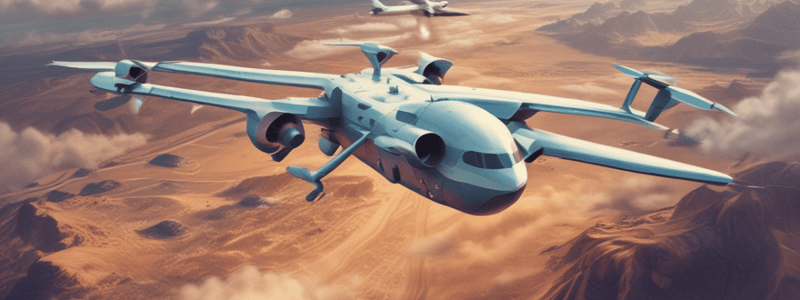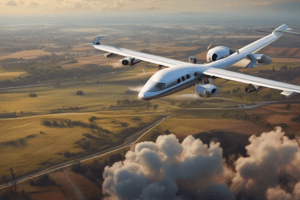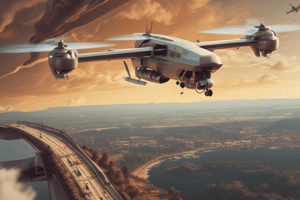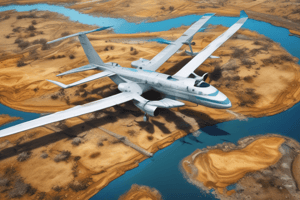Podcast
Questions and Answers
What is the recommended approach for landing a drone?
What is the recommended approach for landing a drone?
- Land without consideration of wind direction or orientation
- Land against the wind and ensure the drone is in Precision Landing mode
- Land into the wind with the drone and pilot oriented the same way (correct)
- Land in any mode for adaptive control during landing
What is the purpose of setting a return-to-home altitude?
What is the purpose of setting a return-to-home altitude?
- To avoid controlled airspace regulations
- To ensure safe clearance above obstacles during return (correct)
- To minimize battery consumption during return
- To limit the drone's maximum flight altitude
Which camera setting is crucial for achieving high-quality images?
Which camera setting is crucial for achieving high-quality images?
- Setting the camera to a JPEG image format
- Adjusting the aperture to f11 for optimal results (correct)
- Utilizing video mode instead of photo mode
- Using autofocus and single shot mode
What is a key element of the pre-flight checklist?
What is a key element of the pre-flight checklist?
Which setting is appropriate for video recording at 30 FPS?
Which setting is appropriate for video recording at 30 FPS?
The return-to-home altitude should be set based on the drone's maximum altitude.
The return-to-home altitude should be set based on the drone's maximum altitude.
In single shot camera mode, autofocus should be turned off.
In single shot camera mode, autofocus should be turned off.
To achieve a smooth dolly zoom effect, the zoom slider should be moved quickly.
To achieve a smooth dolly zoom effect, the zoom slider should be moved quickly.
In video mode, the shutter speed should be set to the same as the frame rate.
In video mode, the shutter speed should be set to the same as the frame rate.
The VPS (Visual Positioning System) is only necessary for indoor flights.
The VPS (Visual Positioning System) is only necessary for indoor flights.
Flashcards are hidden until you start studying
Study Notes
Pre-Flight Checklist
- Set up return-to-home altitude (e.g., 351 ft)
- Ensure obstacle avoidance is turned on
- Set up VPS (Visual Positioning System)
- Check for FAA clearance and controlled airspace regulations
Return-to-Home Protocol
- Set return-to-home altitude based on operating area and obstacle heights (MOCHA - Minimum Obstacle Clearance Altitude)
- Ensure maximum altitude is set (e.g., 400 ft in controlled airspace)
Takeoff Protocol
- Follow the three rules of takeoff:
- Take off into the wind
- Drone and pilot have the same orientation
- Move up and away from the pilot
- Perform a quick control sweep to test the drone's responsiveness
Landing Protocol
- Follow the three rules of landing:
- Land into the wind
- Ensure drone and pilot have the same orientation
- Land in Attitude mode for better control (avoid Precision Landing mode)
Camera Settings
- Turn on autofocus
- Set camera mode to single shot
- Use raw image format for better quality
- Set aperture to f11 for optimal results (based on micro 4/3 sensor)
Panorama Mode
- Take multiple photos and stitch them together
- Use leading lines and framing techniques for better composition
- Experiment with different apertures (e.g., f8, f11) for varying effects
Video Mode
- Set video format to MP4
- Use 4K resolution at 30 FPS
- Set autofocus to continuous or manual focus
- Set shutter speed to twice the frame rate (e.g., 1/120 for 30 FPS)
- Adjust aperture for optimal results (e.g., f11)
- Use the zoom slider for smooth transitions
Dolly Zoom Effect
- Hold the zoom stick while moving the camera for a dolly zoom effect
- Use the reverse pitch and zoom in/out for a trippy effect
- Experiment with different zoom levels and pitch speeds for varying effects
Pre-Flight Checklist
- Set return-to-home altitude, ensuring obstacle avoidance is on and VPS is set up
- Check for FAA clearance and controlled airspace regulations before flight
Return-to-Home Protocol
- Set return-to-home altitude based on operating area and obstacle heights (MOCHA)
- Ensure maximum altitude is set, e.g., 400 ft in controlled airspace
Takeoff Protocol
- Take off into the wind with matching drone and pilot orientation
- Move up and away from the pilot for safe takeoff
- Perform a quick control sweep to test drone responsiveness
Landing Protocol
- Land into the wind with matching drone and pilot orientation
- Land in Attitude mode for better control, avoiding Precision Landing mode
Camera Settings
- Turn on autofocus for clear images
- Set camera mode to single shot for optimal quality
- Use raw image format for better editing capabilities
- Set aperture to f11 for optimal image quality (based on micro 4/3 sensor)
Panorama Mode
- Take multiple photos and stitch them together for seamless panorama
- Use leading lines and framing techniques for better composition
- Experiment with different apertures (e.g., f8, f11) for varying effects
Video Mode
- Set video format to MP4 for compatibility
- Use 4K resolution at 30 FPS for high-quality video
- Set autofocus to continuous or manual focus for smooth tracking
- Set shutter speed to twice the frame rate (e.g., 1/120 for 30 FPS)
- Adjust aperture for optimal results (e.g., f11)
- Use the zoom slider for smooth transitions and professional feel
Dolly Zoom Effect
- Hold the zoom stick while moving the camera for a realistic dolly zoom effect
- Use reverse pitch and zoom in/out for a trippy effect
- Experiment with different zoom levels and pitch speeds for varying effects
Pre-Flight Checklist
- Set return-to-home altitude, ensuring obstacle avoidance is on and VPS is set up
- Check for FAA clearance and controlled airspace regulations before flight
Return-to-Home Protocol
- Set return-to-home altitude based on operating area and obstacle heights (MOCHA)
- Ensure maximum altitude is set, e.g., 400 ft in controlled airspace
Takeoff Protocol
- Take off into the wind with matching drone and pilot orientation
- Move up and away from the pilot for safe takeoff
- Perform a quick control sweep to test drone responsiveness
Landing Protocol
- Land into the wind with matching drone and pilot orientation
- Land in Attitude mode for better control, avoiding Precision Landing mode
Camera Settings
- Turn on autofocus for clear images
- Set camera mode to single shot for optimal quality
- Use raw image format for better editing capabilities
- Set aperture to f11 for optimal image quality (based on micro 4/3 sensor)
Panorama Mode
- Take multiple photos and stitch them together for seamless panorama
- Use leading lines and framing techniques for better composition
- Experiment with different apertures (e.g., f8, f11) for varying effects
Video Mode
- Set video format to MP4 for compatibility
- Use 4K resolution at 30 FPS for high-quality video
- Set autofocus to continuous or manual focus for smooth tracking
- Set shutter speed to twice the frame rate (e.g., 1/120 for 30 FPS)
- Adjust aperture for optimal results (e.g., f11)
- Use the zoom slider for smooth transitions and professional feel
Dolly Zoom Effect
- Hold the zoom stick while moving the camera for a realistic dolly zoom effect
- Use reverse pitch and zoom in/out for a trippy effect
- Experiment with different zoom levels and pitch speeds for varying effects
Studying That Suits You
Use AI to generate personalized quizzes and flashcards to suit your learning preferences.




